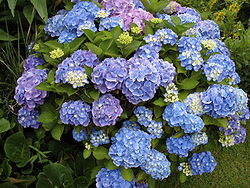紫陽花
Chinese
[edit]purple; violet; imperial purple; violet; imperial; palace |
positive (electric.); sun; male | flower; blossom; to spend flower; blossom; to spend; fancy pattern | ||
|---|---|---|---|---|
| trad. (紫陽花) | 紫 | 陽 | 花 | |
| simp. (紫阳花) | 紫 | 阳 | 花 | |
Pronunciation
[edit]- Mandarin
- (Standard Chinese)+
- Hanyu Pinyin:
- Zhuyin: ㄗˇ ㄧㄤˊ ㄏㄨㄚ
- Tongyong Pinyin: zǐhyánghua
- Wade–Giles: tzŭ3-yang2-hua1
- Yale: dž-yáng-hwā
- Gwoyeu Romatzyh: tzyyyanghua
- Palladius: цзыянхуа (czyjanxua)
- Sinological IPA (key): /t͡sz̩²¹⁴⁻²¹ jɑŋ³⁵ xu̯ä⁵⁵/
- (Standard Chinese)+
- Southern Min
- (Hokkien)
- Pe̍h-ōe-jī: chí-iông-hoe
- Tâi-lô: tsí-iông-hue
- Phofsit Daibuun: cyionghoef
- IPA (Xiamen): /t͡si⁵³⁻⁴⁴ iɔŋ²⁴⁻²² hue⁴⁴/
- IPA (Quanzhou): /t͡si⁵⁵⁴⁻²⁴ iɔŋ²⁴⁻²² hue³³/
- IPA (Zhangzhou): /t͡si⁵³⁻⁴⁴ iɔŋ¹³⁻²² hue⁴⁴/
- IPA (Taipei): /t͡si⁵³⁻⁴⁴ iɔŋ²⁴⁻¹¹ hue⁴⁴/
- IPA (Kaohsiung): /t͡si⁴¹⁻⁴⁴ iɔŋ²³⁻³³ hue⁴⁴/
- (Hokkien)
Noun
[edit]紫陽花
Japanese
[edit]Etymology 1
[edit]| Kanji in this term | ||
|---|---|---|
| 紫 | 陽 | 花 |
| あじさい | ||
| Grade: S | Grade: 3 | Grade: 1 |
| jukujikun | ||
/adisawi/ → /ad͡ʑisai/
From Old Japanese. Recorded in the Man'yōshū of c. 759 CE with the phonetic man'yōgana spellings 味狭藍 (adisawi)[1] and 安治佐為 (adisawi),[2] and in the Wamyō Ruijushō dictionary of 938 CE with the phonetic spelling 阿豆佐為 (adusawi, atusawi).
Ultimate derivation unknown. Some sources[3] suggest that this comes from 集真藍 (adi sa-awi, literally “gathering + pure indigo”). However, this is problematic phonetically, as there is no evidence for any classical or ancient verb 集 (adu, modern azu) that would conjugate to adi (modern aji). The closest with this meaning would be 厚 (atsu), stem of the adjective 厚い (atsui, “thick; packed together”) and root of the classical verb 集む (atsumu, “to gather together”), modern 集める (atsumeru, transitive) and 集まる (atsumaru, intransitive), and this atu (modern atsu) never showed signs of voicing to adu (modern azu), let alone shifting the final vowel from -u to -i. This theory is also problematic semantically, as the hydrangea's color range never includes colors as dark as pure indigo.
Alternatively, the initial adi may be from 味 (ancient adi, modern aji; literally “flavor”), also used as an adjective referring to something good, preferable, or favorable. The sawi may be from -s- as an ancient possessive infix (see also 春雨 (harusame, “spring rain”), 真っ青 (massao, “pure blue, really blue”), 荒稲 (arashine, “unhulled rice”)) and awi from 藍 (ancient awi, modern ai; “indigo”, also used in some contexts to simply mean “blue”).
The spelling is borrowed from Chinese 紫陽花 / 紫阳花 (zǐyánghuā), literally meaning “purple sun flower”, and is an example of jukujikun (熟字訓).
Pronunciation
[edit]- (Tokyo) あじさい [àjísáí] (Heiban – [0])[4]
- (Tokyo) あじさい [àjíꜜsàì] (Nakadaka – [2])[4]
- IPA(key): [a̠ʑisa̠i]
Noun
[edit]紫陽花 or 紫陽花 • (ajisai) ←あぢさゐ (adisawi) or アヂサヰ (adisawi)?
- bigleaf hydrangea (Hydrangea macrophylla)
- 1310, Fuboku Wakashō (book 9, poem 3355)
- hydrangea
Usage notes
[edit]As with many terms that name organisms, this term is often spelled in katakana, especially in biological contexts (where katakana is customary), as アジサイ.
Synonyms
[edit]Derived terms
[edit]- アジサイ科 (ajisai-ka, “Hydrangeaceae”)
- 額紫陽花 (gaku ajisai, “lacecap hydrangea”)
- 沢紫陽花 (sawa ajisai),
- 西洋紫陽花 (seiyō ajisai, “Western hydrangea”)
- 山紫陽花 (yama ajisai, “tea of heaven”)
Proper noun
[edit]- a female given name
Etymology 2
[edit]| Kanji in this term | ||
|---|---|---|
| 紫 | 陽 | 花 |
| し Grade: S |
よう Grade: 3 |
か Grade: 1 |
| on'yomi | kan'on | |
/sijaukwa/ → /ɕijɔːkwa/ → /ɕijoːka/
The reading based on the 音読み (on'yomi) of the kanji spelling, itself borrowed from Chinese 紫陽花 / 紫阳花 (zǐyánghuā).
Pronunciation
[edit]Noun
[edit]紫陽花 or 紫陽花 • (shiyōka) ←しやうくわ (syaukwa) or シヤウクワ (syaukwa)?
Etymology 3
[edit]Other various nanori readings.
Proper noun
[edit]紫陽花 or 紫陽花 or 紫陽花 • (Shōko or Shiyoka or Haruka)
- a female given name
References
[edit]Further reading
[edit]- Etymology entry for 紫陽花 (ajisai) on Gogen-Yurai Jiten (Etymology and Origin Dictionary; in Japanese): http://gogen-allguide.com/a/ajisai.html
- Etymology entry for 紫陽花 (ajisai) on Yurai-Gogen Jiten (Origin and Etymology Dictionary; in Japanese): http://yain.jp/i/紫陽花
- Chinese lemmas
- Mandarin lemmas
- Hokkien lemmas
- Chinese nouns
- Mandarin nouns
- Hokkien nouns
- Chinese terms with IPA pronunciation
- Chinese terms spelled with 紫
- Chinese terms spelled with 陽
- Chinese terms spelled with 花
- Japanese terms spelled with 紫
- Japanese terms spelled with 陽
- Japanese terms spelled with 花
- Japanese terms read with jukujikun
- Japanese terms inherited from Old Japanese
- Japanese terms derived from Old Japanese
- Japanese terms with unknown etymologies
- Japanese terms derived from Chinese
- Japanese terms spelled with jukujikun
- Japanese terms with IPA pronunciation
- Japanese lemmas
- Japanese nouns
- Japanese terms historically spelled with ゐ
- Japanese terms historically spelled with ぢ
- Japanese terms historically spelled with ヰ
- Japanese terms historically spelled with ヂ
- Japanese terms with multiple readings
- Japanese terms spelled with secondary school kanji
- Japanese terms spelled with third grade kanji
- Japanese terms spelled with first grade kanji
- Japanese terms with 3 kanji
- Japanese terms with usage examples
- Japanese proper nouns
- Japanese given names
- Japanese female given names
- Japanese terms spelled with 紫 read as し
- Japanese terms spelled with 陽 read as よう
- Japanese terms spelled with 花 read as か
- Japanese terms read with on'yomi
- Japanese terms historically spelled with わ
- Japanese terms historically spelled with ワ
- ja:Cornales order plants


